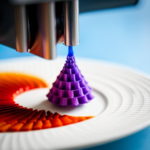Coinciding with the advancements in technology, the integration of 3D printing in education has revolutionized learning experiences. This article delves into the innovative application of 3D food printing for educational purposes.
Exploring its scientific foundations, nutritional implications, and creative potential, it presents a compelling case for incorporating this cutting-edge technology into educational curricula.
From fostering hands-on learning to addressing food sustainability, this article illuminates the exciting potential of 3D food printing in shaping the future of education.
The Science of 3D Food Printing
Exploring the science behind 3D food printing involves understanding the intricate processes of material extrusion, powder binding, and sintering, among other additive manufacturing techniques. The success of 3D food printing lies in the selection of suitable 3D food materials and the printing techniques used.
Various food materials such as chocolate, cheese, dough, and pureed fruits are utilized in 3D food printing. These materials must have the right viscosity and flow properties to be extruded accurately.
Printing techniques can vary from layer-by-layer deposition to sintering powdered ingredients layer by layer to create the desired food product. Material extrusion, the most common 3D printing technique for food, involves the precise deposition of materials layer by layer to form the final 3D food product.
Additionally, powder binding techniques use a binding agent to fuse powdered food materials together, creating intricate and complex food designs. Understanding these 3D food materials and printing techniques is crucial for educators looking to integrate 3D food printing into their curriculum.
Now, let’s delve into how 3D food printing can be integrated into educational settings.
Integrating 3D Printing Into Curriculum
The integration of 3D food printing into educational curriculum presents an opportunity to engage students in understanding the practical application of material extrusion, powder binding, and sintering, as well as the selection and manipulation of suitable 3D food materials in additive manufacturing processes.
Curriculum integration of 3D food printing offers numerous educational benefits. It allows for interactive learning experiences where students can directly engage with the technology, fostering a deeper understanding of its practical applications. By incorporating 3D food printing into the curriculum, students can gain hands-on experience in designing and creating food products, thus enhancing their problem-solving skills and creativity.
Furthermore, it provides a platform for exploring the interdisciplinary nature of 3D printing, integrating aspects of science, technology, engineering, art, and mathematics. This not only enriches the learning experience but also prepares students for the demands of future careers that increasingly require proficiency in emerging technologies.
In essence, integrating 3D food printing into the curriculum not only offers practical applications but also cultivates valuable skills and knowledge essential for the next generation of innovators.
Exploring Nutritional Concepts Through Printing
Through 3D food printing, the exploration of nutritional concepts can be facilitated. This innovative technology allows for the precise control of ingredients, opening up opportunities for culinary exploration and the promotion of nutritional awareness. By using 3D food printing as an educational tool, students can gain a deeper understanding of the nutritional content of various ingredients and their impact on overall health.
| Nutritional Concepts | Benefits |
|---|---|
| Macronutrients | Understanding the role of carbohydrates, proteins, and fats in a balanced diet |
| Micronutrients | Exploring the importance of vitamins and minerals for overall well-being |
| Dietary Restrictions | Creating customized meals for individuals with specific dietary needs |
| Food Sustainability | Investigating ways to minimize food waste and maximize nutritional value |
Hands-On Learning With 3D Food Models
Facilitating hands-on learning with 3D food models enhances students’ grasp of nutritional concepts, fostering a practical understanding of ingredient control and culinary exploration.
- Students experience the joy of creating intricate food designs, igniting their passion for culinary exploration and innovation.
- This interactive learning approach promotes a deeper connection to the food they consume, instilling a sense of responsibility for making healthy choices.
- Through food replication, students gain a profound appreciation for the art and science of cooking, inspiring them to pursue careers in the culinary arts.
Incorporating 3D modeling into culinary education not only cultivates a hands-on approach to learning but also nurtures creativity and critical thinking. By engaging in the process of designing, printing, and assembling 3D food models, students develop a comprehensive understanding of nutrition and the intricate balance of flavors and textures.
This immersive experience lays the foundation for a lifelong appreciation of food and empowers students to make informed decisions about their dietary habits.
Fostering Creativity and Innovation
Fostering creativity and innovation within culinary education through the integration of 3D food modeling encourages students to explore the art and science of cooking with a hands-on, practical approach. By incorporating design thinking, students are prompted to think critically and creatively, tackling culinary challenges in inventive ways. This process nurtures problem-solving skills, as students experiment with new ingredients and techniques to create unique 3D food designs.
Furthermore, the integration of 3D food printing technology sparks innovation by pushing students to explore unconventional ideas and methods, breaking away from traditional culinary norms. This approach empowers students to think beyond the limitations of conventional food preparation, fostering a mindset of continuous improvement and innovation within the culinary arts. As a result, students develop a deep understanding of the relationship between creativity and innovation in the culinary world, preparing them to become future leaders in the field of gastronomy.
This emphasis on creativity and innovation seamlessly transitions into collaborative 3D food printing projects, where students can further apply their problem-solving skills and design thinking in a real-world context.
Collaborative 3D Food Printing Projects
Students engage in collaborative 3D food printing projects to apply problem-solving skills and design thinking in real-world culinary contexts. These projects not only foster creativity but also encourage teamwork and innovation.
Here are some emotional responses to collaborative 3D food printing projects:
-
Excitement: The thrill of combining technology and culinary arts ignites a sense of excitement among students as they witness their creative food designs materialize into tangible, edible creations.
-
Empowerment: Collaborative 3D food printing projects empower students to explore unconventional culinary techniques, fostering a sense of autonomy and confidence in their ability to drive culinary innovation.
-
Inspiration: Working together on these projects sparks inspiration as students witness the limitless possibilities of food design and the potential to revolutionize the culinary industry through their innovative creations.
The fusion of technology and culinary arts in collaborative 3D food printing projects not only cultivates essential skills but also evokes a range of emotions, driving students to push the boundaries of food design and culinary innovation.
Addressing Food Sustainability and Ethics
When exploring food sustainability and ethics in the context of 3D food printing, it is essential to consider the ethical implications of food sourcing, ensuring that the ingredients used are responsibly and ethically obtained.
Additionally, sustainable food production methods and their environmental impact should be thoroughly examined to ensure that 3D printing aligns with sustainable practices and does not contribute to further environmental degradation.
Ethical Food Sourcing
Ethically sourcing food for 3D printing in educational settings is a critical and ongoing consideration for ensuring sustainable and ethical practices. When addressing ethical sourcing, it’s essential to consider the impact on food justice, ensuring that all individuals have access to nutritious and culturally appropriate food.
This involves supporting local farmers and communities, promoting fair labor practices, and reducing the environmental footprint of food production. Additionally, ethical sourcing fosters a sense of responsibility and empathy towards the individuals involved in the food production process, reinforcing the importance of equitable treatment and fair compensation.
Sustainable Food Production
In addressing sustainable food production for 3D printing in educational settings, it is imperative to quantifiably measure the environmental impact of food sourcing and production, ensuring that ethical and sustainable practices are upheld throughout the process.
Sustainable farming practices play a crucial role in achieving this goal, as they emphasize the responsible use of natural resources, reduction of waste, and minimal environmental impact. By integrating sustainable farming methods into food production for 3D printing, educational institutions can demonstrate and promote the importance of ethical and environmentally friendly practices.
Additionally, addressing food security through sustainable food production becomes a key consideration, ensuring that the production of 3D printed food aligns with the goal of providing reliable access to nutritious and culturally appropriate sustenance for all.
Environmental Impact Considerations
Building upon the sustainable farming practices discussed previously, the environmental impact of food 3D printing for educational purposes requires careful consideration and assessment.
This innovative technology has the potential to significantly reduce the carbon footprint associated with traditional food production methods while promoting waste reduction. Additionally, food 3D printing can contribute to resource conservation by utilizing ingredients more efficiently and promoting energy efficiency through precise and localized production.
These factors not only align with the principles of sustainable food production but also have the potential to inspire a sense of responsibility and stewardship towards the environment.
Future Potential of 3D Food Printing
The future potential of 3D food printing lies in its ability to revolutionize culinary education and food production processes. 3D food printing offers a wide array of culinary applications and innovations, enabling chefs and food enthusiasts to explore new dimensions of culinary design and food customization. Below is a table illustrating the diverse potential applications of 3D food printing:
| Culinary Applications | Culinary Innovation | Food Customization |
|---|---|---|
| Customized Food Shapes | Novel Texture | Personalized Diets |
| Decorative Food Art | Unique Flavors | Allergen-Free Options |
| Intricate Food Structures | Experimental Recipes | Tailored Nutrition |
| Culinary Prototyping | Fusion Cuisine | Dietary Restrictions |
| Experiential Dining | Sustainable Practices | Specialized Ingredients |
This technology has the capacity to reshape traditional culinary methods, allowing for greater precision, creativity, and efficiency in food production. Moreover, 3D food printing paves the way for personalized nutrition, catering to individuals with specific dietary needs or preferences. As this technology continues to advance, it holds the promise of transforming the way we perceive, prepare, and consume food, offering endless possibilities for culinary exploration and innovation.
Frequently Asked Questions
What Are the Safety Considerations When Using 3D Food Printing in Educational Settings?
Safety considerations in educational settings involving 3D food printing are critical. Proper food preparation, equipment maintenance, and cross-contamination prevention are essential. Vigilant adherence to safety protocols is paramount to ensure a safe learning environment.
Are There Any Potential Health Concerns Related to Consuming 3D Printed Food?
Health concerns related to consuming 3D printed food primarily revolve around the safety considerations of the printing process, material used, and potential allergens. In educational settings, it’s crucial to address these concerns through rigorous testing and regulation.
How Does 3D Food Printing Technology Contribute to Reducing Food Waste in Educational Environments?
3D food printing technology contributes to reducing food waste in educational environments by allowing precise ingredient dispensing, minimizing leftovers. Its educational benefits include teaching sustainable food practices and encouraging creativity in food production.
What Are the Ethical Implications of Using 3D Food Printing in the Classroom?
The use of 3D food printing in the classroom raises ethical implications related to its impact on educational dynamics, including student engagement and learning outcomes. Educators must carefully consider the ethical considerations and educational impact of integrating this technology.
How Can 3D Food Printing Be Integrated Into Cross-Disciplinary Educational Projects?
Interdisciplinary collaborations in education foster innovative teaching methods. Integration of 3D food printing into cross-disciplinary projects can enhance students’ understanding of technology, nutrition, and design. It offers an opportunity to explore creativity and problem-solving skills.
Conclusion
In conclusion, 3D food printing offers a unique and innovative approach to education by integrating science, nutrition, and creativity.
By incorporating 3D printing into the curriculum, students can gain hands-on experience and explore complex concepts in a tangible way.
This technology has the potential to address food sustainability and ethics, and foster collaboration and innovation.
The future of 3D food printing in education looks promising, offering exciting opportunities for learning and growth.


